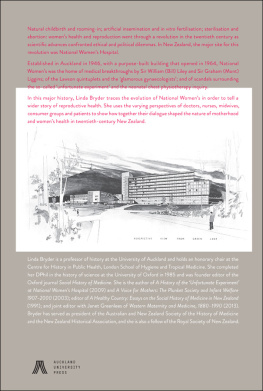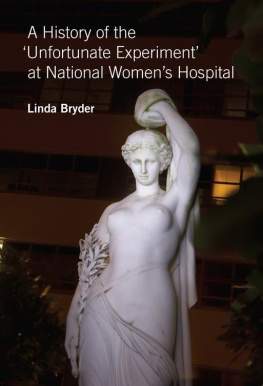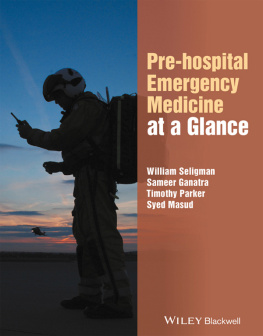The Rise and Fall of National Womens Hospital
A HISTORY
Linda Bryder

Acknowledgements
Since it opened in 1946, National Womens Hospital has been a special place for many Auckland women and the host to a very important event in their lives: childbirth. This includes my mother, my sister and me. My sister was born at the hospital and I paid a brief visit to the premature ward as a oneday-old. My sisters children and my children were subsequently born there, although my first (in 1992) had been planned as a home birth, following the social trends of the day. This generational story can no doubt be repeated by many Auckland women. However, this personal connection was not the motivating factor in writing this history. My academic career has always been in the field of medical and social history, and my interest in the hospital was sparked whilst working on the history of the Royal New Zealand Plunket Society (A Voice for Mothers, AUP, 2003). It was not difficult to see that the absence of an academic history of National Womens Hospital was a major gap in Auckland and New Zealands medical and social history. In 2003 I successfully applied to the Royal Society Marsden Fund to research the history of womens health with a special emphasis on National Womens Hospital. During the course of my general research into the hospital I was diverted into investigating one aspect of the hospitals history, the 198788 Cartwright Inquiry. I felt it important to understand this important event in the hospitals history, and my research led me to some surprising conclusions (A History of the Unfortunate Experiment at National Womens Hospital, AUP, 2009). Now my original, more encompassing, history has finally reached fruition.
Overseas trips to speak to specialist groups and to participate in international conferences are an important part of the research process, enabling constructive feedback and ensuring an eye to international trends. I wish to thank the Marsden Fund for facilitating these opportunities, as well as my colleagues overseas who so willingly listened to me and commented on my work. The Marsden Grant also funded related graduate research projects, completed with distinction by Claire Gooder (PhD thesis) and Gabrielle Bourke and Christina Jeffery (MA theses).
I wish to thank Dr Jenny Carlyon for conducting the interviews for the project, which she undertook with flair and sensitivity. I also wish to thank the people who so generously gave their time and memories of the hospital to enhance the project, and Barbara Batt for typing the transcripts. Thanks too to Glenda Stimpson for facilitating the placement of the Joan Donley papers at the University of Auckland Special Collections, ensuring that this valuable archive is in a secure location for future historical research, and to Stephen Innes, Manager of the Collections, for his speedy and efficient cataloguing of the material. I also appreciated the helpful and friendly staff at the other archives I visited, including the libraries of Parents Centre, Wellington, and the Royal College of Obstetricians and Gynaecologists, London. The team at AUP have my deep appreciation and in particular AUP director Dr Sam Elworthy for his unstinting support and enthusiasm for history. I am very grateful to Dr Ginny Sullivan for once again bringing an astute eye to the manuscript as copy editor, and for her unerring commitment to the task despite nursing a broken foot. I wish to thank my sons, not only for giving me the experience of childbirth but for being there, and finally my partner Derek for his eternal support and patience. I dedicate this book to my mother, Else Bryder, and to my sister, Janne Saunders.
Abbreviations
AJHR | Appendices to the Journals of the House of Representatives |
AMA | Auckland Museum Archives |
ANZA | Archives New Zealand, Auckland |
ANZW | Archives New Zealand, Wellington |
BMJ | British Medical Journal |
CPAP | continuous positive airways pressure |
FNZPC | Federation of New Zealand Parents Centres |
FRCS | Fellow of the Royal College of Surgeons |
HMC | Hospital Medical Committee |
IUD | intrauterine device |
IVF | in vitro fertilisation |
MRCNZ | Medical Research Council of New Zealand |
MRCOG | Member of the Royal College of Obstetricians and Gynaecologists |
NCW | National Council of Women |
NICU | Neonatal Intensive Care Unit |
NMRB | Nurses and Midwives Registration Board |
NZBMA | New Zealand Branch of the British Medical Association |
NZCOM | New Zealand College of Midwives |
NZFPA | New Zealand Family Planning Association |
NZFUW | New Zealand Federation of University Women |
NZH | New Zealand Herald |
NZMA | New Zealand Medical Association |
NZMJ | New Zealand Medical Journal |
NZNJ | New Zealand Nursing Journal: Kai Tiaki |
NZOS | New Zealand Obstetrical Society |
NZOGS | New Zealand Obstetrical and Gynaecological Society |
NZPD | New Zealand Parliamentary Debates |
NZSPWC | New Zealand Society for the Protection of Women and Children |
NZWW | New Zealand Womans Weekly |
PSA | Plunket Society Archives |
RCOG | Royal College of Obstetricians and Gynaecologists |
RDS | respiratory distress syndrome |
SCBU | Special Care Babies Unit |
SPUC | Society for the Protection of the Unborn Child |
UOAA | Archives, Office of the Vice-Chancellor, University of Auckland |
UOASC | University of Auckland Library, Special Collections |
WHO | World Health Organization |
Introduction
At the opening of New Zealands new purpose-built National Womens Hospital in 1964 Sir Douglas Robb, Chancellor of the University of Auckland, recounted his feelings upon returning from overseas and hearing the news of the first-ever successful antenatal blood transfusion, performed at the hospital. He said, No longer do we necessarily turn our back on intellectual and scientific progress when we leave Europe and America for down-under. Here we were heading towards the news and not away from it. It was a grand feeling for a native New Zealander.
By the time of Turners appointment, however, the hospitals research programme was in tatters, its leaders in disgrace and its public image at an all-time low. When her predecessor as professor, Dennis Bonham, died in 2005 the New Zealand Herald declared that he would be best remembered for the role he played in the Unfortunate Experiment, and ignored his long and distinguished career, both nationally and internationally, which had spanned three decades. It is now time to try to restore some balance to the history of what was clearly an important institution in New Zealands medical history.








